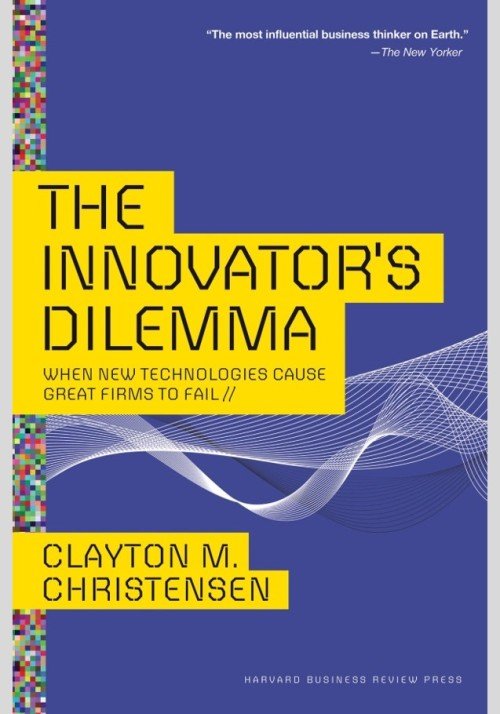
Introduction
In today's rapidly evolving world, technological advancements are reshaping industries and disrupting traditional business models. In his groundbreaking book, "The Innovator's Dilemma: When New Technologies Cause Great Firms to Fail," Clayton M. Christensen explores the challenges that established companies face when confronted with disruptive innovations. Published in 1997, this seminal work continues to offer valuable insights into the dynamics of technological disruption and serves as a guide for companies seeking to thrive in an era of constant change.
Understanding the Innovator's Dilemma
"The Innovator's Dilemma" introduces a paradoxical situation faced by successful organizations. It explains how well-managed companies, which are adept at identifying and meeting the needs of existing customers, can struggle to adapt to disruptive technologies that emerge seemingly out of nowhere. Christensen argues that companies that focus solely on sustaining innovations and serving their current customer base may fail to recognize or invest in disruptive technologies that have the potential to revolutionize their industries.
The Innovator's Dilemma refers to the difficult choices and challenges that successful companies face when disruptive technologies emerge in their industries. It was introduced by Clayton M. Christensen in his influential book, "The Innovator's Dilemma: When New Technologies Cause Great Firms to Fail."
At the core of the Innovator's Dilemma is the distinction between sustaining and disruptive innovations. Sustaining innovations are incremental improvements made to existing products or services to meet the evolving needs of current customers. Established companies are typically adept at pursuing sustaining innovations to maintain their market position and satisfy their customer base.
Disruptive innovations, on the other hand, are game-changing technologies or business models that initially serve niche markets or underserved customer segments. These innovations often possess lower performance, simpler designs, and lower costs compared to existing solutions. Initially, they may not be as appealing to mainstream customers or meet the high standards of established markets.
The dilemma arises when successful companies, focused on serving their existing customers and pursuing sustaining innovations, fail to recognize the potential of disruptive technologies. These companies face internal barriers, such as entrenched structures, processes, and cultures that favor incremental improvements rather than radical change. They often hesitate to invest in disruptive technologies that may not deliver immediate returns or align with their current business models.
Moreover, disruptive technologies may disrupt the established value networks within an industry. Incumbent companies often have well-established relationships, distribution channels, and partnerships that are optimized for their current offerings. Disruptive technologies, with their different value propositions and market dynamics, can challenge and potentially undermine the existing industry structure, leaving incumbents at a disadvantage.
The consequences of not addressing the Innovator's Dilemma can be severe. Incumbent companies risk losing their competitive edge or even facing extinction as disruptive technologies gain traction and attract customers from underserved segments. The book provides numerous case studies across industries such as steel, disk drives, and computers, demonstrating how companies that failed to adapt to disruptive technologies ultimately fell behind or disappeared from the market.
To overcome the Innovator's Dilemma, companies need to be proactive and open to disruptive innovations. They should create separate entities or units that focus on exploring and developing disruptive technologies, free from the constraints of the core business. These separate units can experiment, iterate, and build expertise in disruptive technologies without being impeded by the existing organizational structures and processes.
Furthermore, companies should pay attention to non-traditional customers and emerging markets that may be early adopters of disruptive innovations. By understanding and addressing the needs of these customers, companies can gain valuable insights and establish a foothold in the growing disruptive market segments.
In summary, the Innovator's Dilemma is a concept that highlights the challenges faced by successful companies when disruptive technologies emerge. By recognizing the distinction between sustaining and disruptive innovations, understanding the internal and external barriers to change, and adopting strategies that embrace disruptive technologies, companies can navigate the dilemma and position themselves for long-term success in a rapidly changing business landscape.
Sustaining vs. Disruptive Innovations
The book draws a distinction between sustaining and disruptive innovations. Sustaining innovations are incremental improvements made to existing products or services, aimed at meeting the evolving needs of current customers. These innovations are typically embraced by established companies and are essential for maintaining their market position.
On the other hand, disruptive innovations are fundamentally different. They often start as niche products or services that initially cater to a small, underserved market segment. Disruptive technologies are characterized by their lower performance, simplicity, and lower cost compared to existing products or services. Initially, these technologies may not be attractive to mainstream customers or meet the performance standards of established markets.
The Perils of Success
According to Christensen, successful companies often fail to recognize the potential of disruptive technologies because they are too focused on meeting the demands of their most profitable customers. By allocating resources and efforts towards sustaining innovations, companies become vulnerable to disruption. Their deep-rooted structures, processes, and cultures become a barrier to embracing disruptive technologies that may seem less promising in the short term.
The Innovator's Dilemma unfolds through various real-world case studies, highlighting the downfall of once-dominant companies. Christensen examines industries such as steel, disk drives, and the computer industry, providing compelling evidence of the challenges faced by incumbents when confronted with disruptive technologies.
Overcoming the Dilemma
"The Innovator's Dilemma" also offers guidance on how companies can navigate these challenges and seize opportunities presented by disruptive technologies. Christensen emphasizes the need for organizations to create separate units or entities that focus on exploring and developing disruptive innovations. By isolating these projects from the core business, companies can allocate resources and foster a culture conducive to experimentation and risk-taking.
Another key strategy highlighted in the book is the importance of listening to and understanding the needs of non-traditional customers. Disruptive technologies often cater to underserved market segments, and successful companies should pay attention to these early adopters who can drive the growth of disruptive innovations.
Conclusion
"The Innovator's Dilemma" remains a foundational text for understanding the challenges faced by established companies in the face of disruptive technologies. Clayton M. Christensen's book provides valuable insights into the dynamics of innovation and disruption and offers strategies to help companies adapt and thrive in a rapidly changing business landscape. By recognizing the potential of disruptive technologies and fostering a culture of innovation, companies can position themselves for long-term success in an increasingly unpredictable world.








